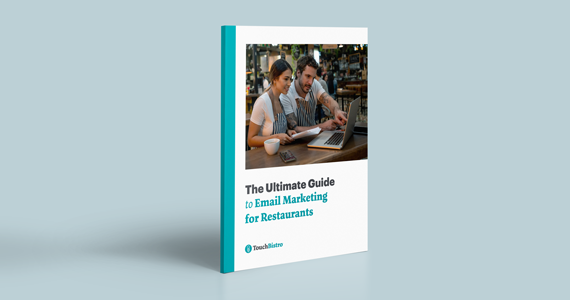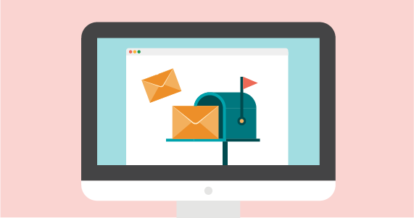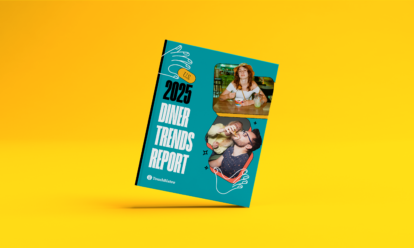Few marketing channels are as effective as restaurant email marketing. A whopping 59% of people say that marketing emails influence their purchase decisions. And, email has proven to generate the highest return on investment of any marketing channel at $38 for every $1 spent.
Not only does email marketing generate great results for businesses, but it’s also one of the easiest restaurant marketing ideas to execute. Many Email Service Providers (ESPs) have made it incredibly easy to create and send email campaigns with mobile-friendly email templates, drag-and-drop builders, marketing automation, and more.
Of course, if you’re new to email marketing for restaurants, there are a few basics to learn, including how to create a restaurant email marketing plan, what kinds of emails to send, and how to measure your success. It’s also important to understand how email fits into your overall restaurant marketing strategy.
That’s where our guide comes in. In this handy, 6-step guide to email marketing for restaurants, you’ll learn:
- How to find the right email marketing solution for your restaurant
- The 6 steps involved in launching a restaurant email marketing strategy
- Some inspiration for your restaurant newsletter and other email campaigns

Learn how to set up an email marketing strategy for your business in 6 easy steps.
Finding an Email Marketing Solution for Your Restaurant
Before you can start sending emails to customers, you need to find the right email marketing solution for your restaurant. Fortunately, this is an easy step.
As mentioned already, an ESP is a service that’s specifically been designed to help you to build email lists and send emails to your subscribers. An ESP can also help you grow your list of contacts, design and build customized email templates, create targeted email campaigns, and much more. And while this may sound like a lot, today’s ESPs are incredibly user-friendly so you can launch email campaigns with little to no technical knowledge.
When looking for an ESP for your restaurant, your best bet is to choose a service that’s integrated with your restaurant loyalty program (if you have one). That’s because your loyalty program is likely your biggest source of customer data, so you want to make sure you can easily reach everyone in your rewards program. For instance, if you already use TouchBistro Loyalty, you can add the TouchBistro Marketing integration, which gives you the ability to create engaging email and in-app campaigns (among many other things). Using both solutions allows you to bring your customer spend data, marketing campaigns, and insights together for a 360-degree customer engagement solution – all on one platform.
However, if you don’t have a loyalty program in place just yet, you can always use a standalone ESP such as Mailchimp, Sendinblue, or Benchmark. Many of these services are free to use if you’re starting with a very small list of contacts. If you’re looking for something more robust, you might opt for a solution like TouchBistro Marketing, which not only allows you to create and automate email marketing campaigns, but gives you the ability to create custom promotions, segment diner data with a built-in CRM, set up a custom-branded web app, and more.
Regardless of what type of solution you’re looking for, when choosing a new ESP, make sure to look for the following:
- A user-friendly email builder
- A rich selection of customizable, pre-built email templates that are optimized for mobile
- Customer relationship management tools
- Automation and segmentation tools
- In-depth email metrics and reports
Launching a Restaurant Email Marketing Strategy in 6 Steps
Once you’ve picked an ESP that fits your budget, skill level, and preferred ease of use, it’s time to get to the fun stuff: launching your very first email campaign. Below, we’ll explain how to create and launch your restaurant emails in just 6 steps. You can also dive deeper by downloading our free guide to email marketing for restaurants.
1. Make a Plan
Every restaurant is different, which means you’ll also need to create a unique email marketing campaign for your business.
Establish Your Brand
If your restaurant is new or you’re simply new to marketing, it’s important to establish your brand image and tone. You can get a better idea of your brand’s look and feel by asking the following questions:
- Is your restaurant upscale?
- What is your atmosphere? Are you friendly and casual? Or are you reserved and elegant?
- Are you a full service or a limited service restaurant?
- Who is your target audience? Consider making a buyer persona to define who your ideal customer is.
Questions like these will help you determine what kind of email templates you should use, what tone to write in, what content you should include, and even when to send your restaurant emails.
Just take the example of Ottos Bierhalle’s restaurant newsletter. The restaurant is a full service venue that caters to young customers in one of Toronto’s hippest neighborhoods. As a result, the brand’s emails feature fun graphic designs, casual language, and news about the restaurant growler program.
Set Your Goals
With your brand identity firmly established, it’s important to set goals for your email marketing campaigns. After all, without goals, it will be hard to know whether your email strategy is working.
When setting goals for your restaurant email marketing strategy, ask yourself the following:
- What’s the main purpose of the email channel and of each campaign? This can be as simple as keeping your customers up to date on the latest news, or maybe you have a specific objective like boosting takeout sales or improving restaurant customer loyalty. Make some decisions about what you’re trying to convey with your emails and what actions you want your subscribers to take.
- Who are your emails for? Think about who is receiving your restaurant emails and what motivates them. Remember, your target audience doesn’t just impact your branding, but also how you structure your email campaigns.
- How will you measure performance? The best way to measure the performance of your emails is to track key performance indicators (KPIs) such as open rates, click-through rates, and unsubscribe rates. Just keep in mind that the metrics you track will vary depending on the goal of each email campaign.
2. Build a List of Contacts
With a plan in place, the next step is building your restaurant email list of subscribers.
There are many ways to collect emails for your restaurant email marketing list, such as:
- A subscription form on your restaurant website
- The signup page or app for your restaurant’s loyalty program
- Your reservations page
- In exchange for access to your restaurant’s WiFi
- Via a tab on your restaurant’s Facebook page
- On questionnaires and other feedback forms
While there are many ways to collect emails, keep in mind that you can’t simply add anyone to your email list. In Canada, the U.K., and European Union countries, customers must explicitly opt-in to your email list (give you permission to email them) before you can begin sending them emails. And in the U.S. it is mandatory that you provide users with a clear means of opting out of or unsubscribing from further contact.
Therefore, always ensure you have a clear understanding of your country’s anti-spam laws before building your restaurant email list.
3. Segment Your Contact List
As you begin to accumulate email subscribers, your next step to segment your restaurant email list. Segmenting your contacts means taking all the email subscribers in your restaurant CRM and dividing them into smaller groups based on specific criteria (i.e. location, previous orders, loyalty program membership, etc.). The idea is that by separating your contacts into different groups, you can create emails that speak to specific interests or behaviors, rather than trying to create one message that caters to everyone.
For example, if you use the TouchBistro Loyalty and Marketing integration, you can create targeted promotions based on the habits and behaviors of your loyalty program members. This could be as specific as sending an email about a new burger to everyone who has purchased burgers in the past, or sending a special discount code to those who haven’t visited your restaurant in the past 30 days. The more targeted promotions you create, the more likely your subscribers are to take the desired action.
4. Design and Write Your Emails
While setting up your email campaigns may be a little technical, the process of designing and writing your emails is an opportunity for you to let your creativity shine.
Designing Your Email
Are your graphic design skills a little rusty? No problem. If you’re using an ESP, most solutions come with beautiful, pre-built templates that take care of most of the design process for you. And once you’ve chosen a pre-built template, customizing the design is often as simple as using a drag-and-drop builder to change the layout.
When customizing your email template, keep the following in mind:
- Consistent branding: Ensure any colors, fonts, photography, and other design elements match the rest of your restaurant branding.
- A logical and simple layout: The content in your emails should flow logically from one thing to the next, with your best content featured first. To avoid overwhelming your reader, aim for no more than three content blocks in each email.
- High-quality images: Any images – whether it’s photos or your logo – should be high-quality, and not blurry or pixelated.
- Optimize for mobile: 81% of people prefer to open emails on their phones, so ensure the email template you choose works on mobile, desktop, and other devices.
This email from Washington, DC restaurant Anchovy Social is a great example of a design that checks off all the boxes. All the information in the email flows logically, the colors and font match the restaurant’s branding, and high-quality images are used throughout.
Writing Your Emails
After finalizing your design, the next step is to start writing. When filling out your restaurant emails, keep these six elements in mind:
- The Subject Line: The subject line is the first thing your subscribers will read and it plays the biggest role in whether or not people open your email. Since most people view emails on iPhones and Gmail, the ideal subject line length is about 41 characters.
- Preheader Text: Preheader text directly follows your subject line and provides subscribers with a little more context about what’s inside the email. Your preheader text should be somewhere in the range of 40 to 130 characters long.
- Headlines: Headlines provide readers with immediate context for what’s in your email. Keep your headlines short and simple to encourage subscribers to read the rest of the text.
- The Body: Use the body of your email to inform and educate your subscribers. Aim to keep things concise and try not to overload the reader with too much text.
- Call to Action (CTA) Buttons: A CTA button is a prompt that tells the reader to take a specified action, such as “Learn More” or “Order Now.”
- The Footer: Add your contact information to the end of every email so your subscribers know how to reach you. Most ESPs makes this easy to do by letting you set up a footer that automatically adds this information to the bottom of every email you send.
Though it may seem simple, this Mother’s Day email from Union Square Hospitality Group perfectly conveys its message to subscribers with strategic headlines, text, and CTA buttons.
5. Automate Your Emails
In addition to sending out business-as-usual emails, an important part of email marketing for restaurants is setting up automated campaigns. Automated emails are prepared emails sent to your subscribers automatically from your ESP, based on a predetermined schedule or specific triggers.
In the context of restaurant email marketing, there are two main types of automated email campaigns to consider:
- Lifecycle Campaigns: These are emails tailored to the individual characteristics of your guests that are sent throughout the customer’s lifecycle. For example, an email on the customer’s birthday or the anniversary of their first purchase.
- Trigger Campaigns: These are emails sent based on triggered behavior. For example, you might send out a welcome email every time someone signs up for your restaurant email list.
Most ESPs make it easy to create both of these types of automated campaigns so you can set it and forget it.
6. Analyze the Results
After you’ve officially begun sending emails to your subscribers, the final step is analyzing the results of those emails so you know what’s working and what’s not working.
The best way to analyze your emails is to track key performance indicators (KPIs), which are values that measure the performance of different aspects of your email campaigns. Most ESPs make it easy to track the following KPIs:
- Delivery Rate: This is the percentage of emails you send that are actually delivered to people’s inboxes. This figure can be affected by incorrect email addresses or email filters that may cause your messages to bounce.
- Open Rate: The percentage of people who open your email.
- Click Rate: The percentage of people who click on something in your email.
- Unsubscribe Rate: The percentage of people who unsubscribe from your email list.
To give you an idea of what numbers you should aim for, a study by Mailchimp found that the average open rate for restaurant emails was 19.77%, the average click rate was 1.34%, and the average unsubscribe rate was 0.28%.

Learn how to set up an email marketing strategy for your business in 6 easy steps.
Email Marketing Ideas for Your Restaurant
Now that we’ve covered the technical side of email marketing for restaurants, you’re probably wondering what to send in your own emails. To help you get started, we’ve rounded up some common email marketing ideas for restaurants.
1. Newsletters
One of the most common types of emails you can send is a restaurant newsletter. This is an email that delivers the latest news or updates from your restaurant, but it can also feature engaging content such as blog posts, staff stories, recipes, and more. Your restaurant’s newsletters can take many different forms and be sent at different frequencies (i.e. once a week, once a month, quarterly, etc.).
For example, this monthly newsletter from the Avling brewery and restaurant encourages readers to learn more about its rooftop garden.
2. Welcome Emails
Whenever someone opts into your restaurant email list, your loyalty program, or another program you offer, you should confirm their sign-up with a welcome email. A welcome email provides subscribers with confirmation that they’ve signed up to receive emails from you, and it gives you an opportunity to make a good first impression with an introduction to your business, or even a special offer. For example, Bruegger’s Bagels sends subscribers a coupon for a free bagel with cream cheese in the welcome email for its newsletter.

3. Menu Updates
Whether you’ve revamped an old dish or created something entirely new, let customers know about it. This is exactly what Toronto’s Planta has done with the launch of its raw, plant-based cookie dough cups.
4. Promotions and Special Offers
Special offers are a great way to get customers in the door. If you’re running a restaurant-wide promotion, you might send an email to all your subscribers like Emmy Squared did for its pizza and burger kits.
However, if you’re looking to bring in specific customers, you might create personalized promotions. For instance, with the TouchBistro Loyalty and Marketing integration, you can create promotions for specific loyalty members based on spend, orders placed, number of visits, or other diner behavior. For example, you could send a two-for-one breakfast sandwich promotion that is only sent to loyalty program members who have ordered breakfast sandwiches in the past.
5. Surveys and Review Requests
Interested in what your customers think of your restaurant? An easy way to collect feedback is to send surveys or review requests to customers via email.
If you use a restaurant reservation system or loyalty program, you can easily request diner feedback via email. For example, the seafood restaurant Eastside Social uses TouchBistro Reservations to send review requests after each diner’s visit.

Learn how to set up an email marketing strategy for your business in 6 easy steps.
Though there’s a lot you can do with restaurant email marketing, you don’t have to try everything at once. Download our guide to email marketing for restaurants, start with some common strategies, and figure out what kind of restaurant emails your subscribers respond to. Over time, you’ll not only see your restaurant email list grow, but you’ll also start to reap the rewards of this valuable marketing channel.
Free social media templates for your restaurant
Sign up for our free weekly TouchBistro Newsletter







